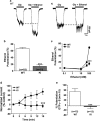Altered sedative effects of ethanol in mice with α1 glycine receptor subunits that are insensitive to Gβγ modulation
- PMID: 24801766
- PMCID: PMC4207329
- DOI: 10.1038/npp.2014.100
Altered sedative effects of ethanol in mice with α1 glycine receptor subunits that are insensitive to Gβγ modulation
Abstract
Alcohol abuse and alcoholism are major health problems and one of the leading preventable causes of death. Before achieving better treatments for alcoholism, it is necessary to understand the critical actions of alcohol on membrane proteins that regulate fundamental functions in the central nervous system. After generating a genetically modified knock-in (KI) mouse having a glycine receptor (GlyR) with phenotypical silent mutations at KK385/386AA, we studied its cellular and in vivo ethanol sensitivity. Analyses with western blotting and immunocytochemistry indicated that the expression of α1 GlyRs in nervous tissues and spinal cord neurons (SCNs) were similar between WT and KI mice. The analysis of synaptic currents recorded from KI mice showed that the glycinergic synaptic transmission had normal properties, but the sensitivity to ethanol was significantly reduced. Furthermore, the glycine-evoked current in SCNs from KI was resistant to ethanol and G-protein activation by GTP-γ-S. In behavioral studies, KI mice did not display the foot-clasping behavior upon lifting by the tail and lacked an enhanced startle reflex response that are characteristic of other glycine KI mouse lines with markedly impaired glycine receptor function. The most notable characteristic of the KI mice was their significant lower sensitivity to ethanol (∼40%), expressed by shorter times in loss of righting reflex (LORR) in response to a sedative dose of ethanol (3.5 g/Kg). These data provide the first evidence to link a molecular site in the GlyR with the sedative effects produced by intoxicating doses of ethanol.
Figures





Similar articles
-
Characterization of two mutations, M287L and Q266I, in the α1 glycine receptor subunit that modify sensitivity to alcohols.J Pharmacol Exp Ther. 2012 Feb;340(2):304-16. doi: 10.1124/jpet.111.185116. Epub 2011 Oct 28. J Pharmacol Exp Ther. 2012. PMID: 22037201 Free PMC article.
-
Effects of ethanol on glycinergic synaptic currents in mouse spinal cord neurons.J Neurophysiol. 2014 May;111(10):1940-8. doi: 10.1152/jn.00789.2013. Epub 2014 Feb 26. J Neurophysiol. 2014. PMID: 24572089 Free PMC article.
-
Manipulations of extracellular Loop 2 in α1 GlyR ultra-sensitive ethanol receptors (USERs) enhance receptor sensitivity to isoflurane, ethanol, and lidocaine, but not propofol.Neuroscience. 2015 Jun 25;297:68-77. doi: 10.1016/j.neuroscience.2015.03.034. Epub 2015 Mar 28. Neuroscience. 2015. PMID: 25827497 Free PMC article.
-
Ethanol effects on glycinergic transmission: From molecular pharmacology to behavior responses.Pharmacol Res. 2015 Nov;101:18-29. doi: 10.1016/j.phrs.2015.07.002. Epub 2015 Jul 6. Pharmacol Res. 2015. PMID: 26158502 Free PMC article. Review.
-
Glycine Receptor Drug Discovery.Adv Pharmacol. 2017;79:225-253. doi: 10.1016/bs.apha.2017.01.003. Epub 2017 Mar 21. Adv Pharmacol. 2017. PMID: 28528670 Review.
Cited by
-
Reduced sedation and increased ethanol consumption in knock-in mice expressing an ethanol insensitive alpha 2 subunit of the glycine receptor.Neuropsychopharmacology. 2021 Feb;46(3):528-536. doi: 10.1038/s41386-020-0689-9. Epub 2020 May 1. Neuropsychopharmacology. 2021. PMID: 32357359 Free PMC article.
-
Potentiation of Gamma Aminobutyric Acid Receptors (GABAAR) by Ethanol: How Are Inhibitory Receptors Affected?Front Cell Neurosci. 2016 May 6;10:114. doi: 10.3389/fncel.2016.00114. eCollection 2016. Front Cell Neurosci. 2016. PMID: 27199667 Free PMC article. Review.
-
Positive Allosteric Modulators of Glycine Receptors and Their Potential Use in Pain Therapies.Pharmacol Rev. 2022 Oct;74(4):933-961. doi: 10.1124/pharmrev.122.000583. Pharmacol Rev. 2022. PMID: 36779343 Free PMC article. Review.
-
Overexpression of wild type glycine alpha 1 subunit rescues ethanol sensitivity in accumbal receptors and reduces binge drinking in mice.Neuropsychopharmacology. 2023 Aug;48(9):1367-1376. doi: 10.1038/s41386-022-01459-2. Epub 2022 Sep 29. Neuropsychopharmacology. 2023. PMID: 36175550 Free PMC article.
-
Influence of nonsynaptic α1 glycine receptors on ethanol consumption and place preference.Addict Biol. 2020 Mar;25(2):e12726. doi: 10.1111/adb.12726. Epub 2019 Mar 18. Addict Biol. 2020. PMID: 30884072 Free PMC article.
References
-
- Aguayo LG. Potentiation of the glycine-activated Cl− current by ethanol in cultured mouse spinal neurons. J Pharmacol Exp Ther. 1996;279:1116–1122. - PubMed
-
- Aguayo LG, Pancetti FC. Ethanol modulation of the γ-aminobutyric acidA- and glycine-activated Cl− current in cultured mouse neurons. J Pharmacol Exp Ther. 1994;270:61–69. - PubMed
-
- Aguayo LG, van Zundert B, Tapia JC, Carrasco MA, Alvarez FJ. Changes on the properties of glycine receptors during neuronal development. Brain Res Rev. 2004;47:33–45. - PubMed
-
- Azzarito V, Long K, Murphy NS, Wilson AJ. Inhibition of alpha-helix-mediated protein-protein interactions using designed molecules. Nat Chem. 2013;5:161–173. - PubMed
Publication types
MeSH terms
Substances
Grants and funding
LinkOut - more resources
Full Text Sources
Other Literature Sources
Molecular Biology Databases
Research Materials

